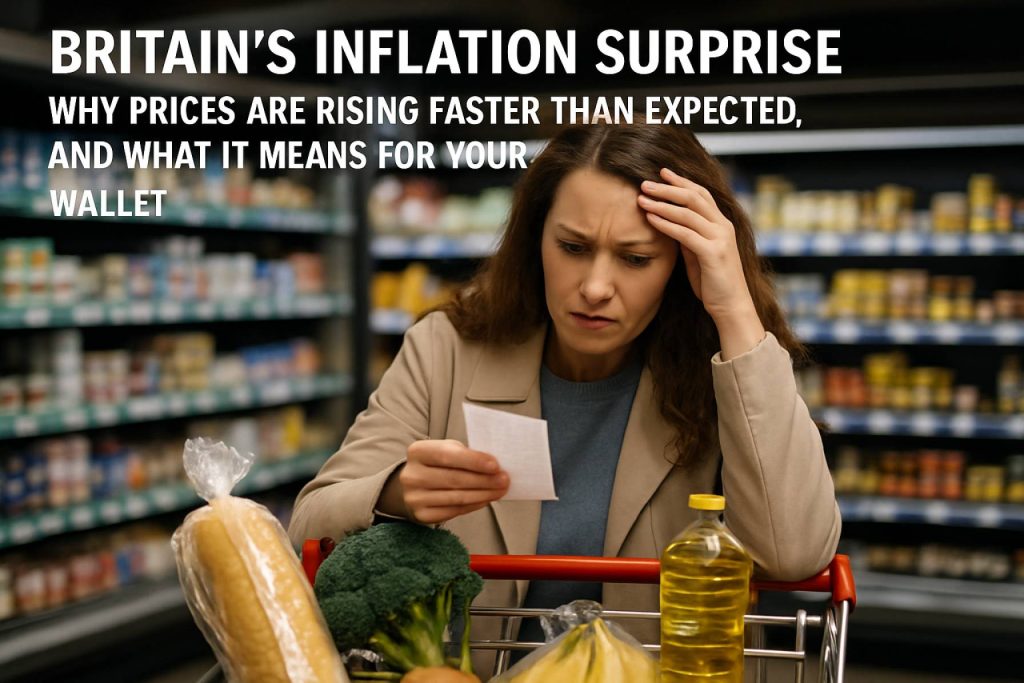
- UK inflation rose to 3.5% in April, surpassing forecasts and breaking the recent downward trend.
- Core inflation jumped to 3.8%, signaling broad price pressures beyond food and energy.
- Housing and utilities, especially electricity, gas, and water, saw steep price increases.
- Transport and recreation costs contributed to higher inflation, while clothing prices provided slight relief.
- Water and sewerage prices spiked 26.1% in a month, the sharpest jump since 1988.
- The Bank of England cut rates to 4.25% in May, but policymakers now urge caution on further cuts.
- GDP growth surprised on the upside, but volatility and cost-of-living pressures are expected to persist.
Shoppers roaming the fluorescent-lit aisles of London’s bustling supermarkets may have sensed it, even before the new data landed. Against the rush of colourful packaging and the hum of self-checkouts, the truth lingered in the air: everyday items are costing more. The Office for National Statistics confirmed the uncomfortable suspicion this week, revealing that the U.K.’s annual inflation rate has climbed to 3.5% in April—outpacing analyst expectations and jolting households across the country.
Analysts had forecast a milder increase to 3.3%, but the numbers broke the trend of the past few months, when inflation fell to 2.8% in February and further to 2.6% in March. The shock runs deeper for core inflation—a measure that strips out volatile items like food and energy—which leapt to 3.8% from 3.4% only a month prior. For British families, these statistics aren’t just numbers; they materialize as creeping prices at the till and starker choices at home.
- Housing and household services took the lion’s share of the upward pressure, driven by a 6.7% year-on-year surge in electricity, gas, and fuel costs.
- Transport, recreation, and culture also nudged the figures upwards, as British springtime brought both holiday demand and higher travel costs.
- The one relief? Clothing and footwear helped temper the rise, albeit not enough to cushion household budgets.
Perhaps most striking, the price of water and sewerage leapt by 26.1% in a single month—to its highest monthly uptick since 1988—turning a basic necessity into a stark symbol of inflation’s reach. Across the country, families adjusting thermostats and weighing weekend getaways now add a new calculation: how much further can their pounds stretch?
Rachel Reeves, Britain’s Chancellor, captured the mood succinctly: “Disappointed” by the numbers, she acknowledged the relentless grip that cost-of-living pressures have on working people. Meanwhile, economists and policymakers scrambled to dissect the causes: a new jump in the energy price cap, business taxes rising with the April thaw, and even the weather coaxing some spending into early spring.
- The Bank of England had already trimmed its base interest rate to 4.25% in early May, hoping to nurture growth while holding the inflation beast at bay.
- However, at least two monetary policy committee members had warned against cutting rates, and the fresh data may justifies their caution.
As the BOE deliberates, it faces both risk and opportunity. A temporary peak in inflation—perhaps up to 3.7% in the coming months—was on its radar due to energy and regulated price hikes. But with rising global tariffs and domestic cost surges, its path forward must be, in its own words, “gradual and careful.” The target remains the familiar 2%, though today it feels more distant, pushed out by market forces and international politics alike.
There are faint positives: preliminary GDP numbers for the first quarter surprised with a robust 0.7% gain, fueled by last-minute activity ahead of U.S. trade tariffs and the April business tax hike. Still, few expect the momentum to last. As Julien Lafargue of Barclays Private Bank observed, volatility will persist, but the overall trajectory for inflation could soon trend lower—handing the central bank leeway to consider further rate cuts in the second half of the year.
For now, the story of British inflation is a tangled one, spun from global tensions, policy debates, and the everyday lives of those facing rising utility bills and supermarket prices. As the debate unfolds, all eyes remain on the coming months—when the numbers, and the reality behind them, will reveal which way the scales tip for the people of Britain.
Shocking Truths About U.K. Inflation: Who Wins, Who Loses, and Who Decides?
-
Pro: Independent Oversight and Data Reliability
Inflation data are verified and published by the Office for National Statistics, ensuring credibility for economists and the public alike.
-
Pro: Potential for Policy Adjustment
The Bank of England can use up-to-date inflation metrics to justify or reconsider interest rate changes, potentially supporting consumers if inflation eases.
-
Con: Devastating Impact on Household Budgets
With energy, water, and transport costs climbing, families face immediate, real-world pressures while wage growth stalls behind price increases.
-
Con: Policy Dilemmas and Internal Division
The Bank of England is divided about lowering rates, risking either runaway inflation or stalled economic growth.
-
Controversy: Are Inflation Measures Enough?
Even with strong oversight, critics question whether official inflation rates adequately reflect the lived experience, especially as essentials like water prices spike by historic margins.
-
Limitation: Volatility and External Shocks
Both the ONS and Bank of England admit forecasts can be swayed easily by global events, commodity prices, and sudden policy changes, making predictions—and planning—a constant challenge.
UK Inflation Shock: What Lies Ahead? Top Predictions for the Coming Years
-
Inflation Rates Poised for Fluctuation
Experts from the Bank of England anticipate inflation remaining above the 2% target throughout the next year, potentially peaking near 3.7% before showing signs of stabilization or gradual decline in late 2025. Ongoing energy and regulated price hikes will likely cause continued volatility before eventual moderation.
-
Interest Rates: Cautious Easing Likely
Following the recent rate cut to 4.25%, analysts expect the Bank of England to consider further, but measured, reductions in interest rates. Decisions will hinge on actual inflation data and how price pressures evolve, with policymakers maintaining a “gradual and careful” approach to any monetary shifts.
-
Energy and Utility Costs Under Scrutiny
With water and sewerage prices surging by over 26% in one month, regulatory bodies and utility providers will face pressure to moderate future hikes. Watchdog agencies, informed by reports from the Office for National Statistics, may influence tariff setting and consumer protection initiatives in the essential utilities sector.
-
Consumer Spending to Adjust
Households are expected to shift spending habits, prioritizing essentials and potentially reducing outlays on recreation and travel. Reports from the ONS indicate continued strain on disposable incomes, with businesses adapting to more value-conscious consumers in the years ahead.
-
Policy and Fiscal Changes Ahead
The UK government, led by Chancellor Rachel Reeves, is forecast to roll out targeted support for vulnerable groups and may implement new fiscal measures if inflation persists at high levels. Ongoing policy responses will be closely tied to updated statistics and economic indicators provided by the ONS and input from the Bank of England.
-
Global Risks Remain
International factors—such as trade tariffs, energy market volatility, and geopolitical instability—are likely to continue influencing inflation trends in the UK. Policymakers and market analysts will be monitoring developments and projections from institutions like the Bank of England and ONS for early warning signals.



